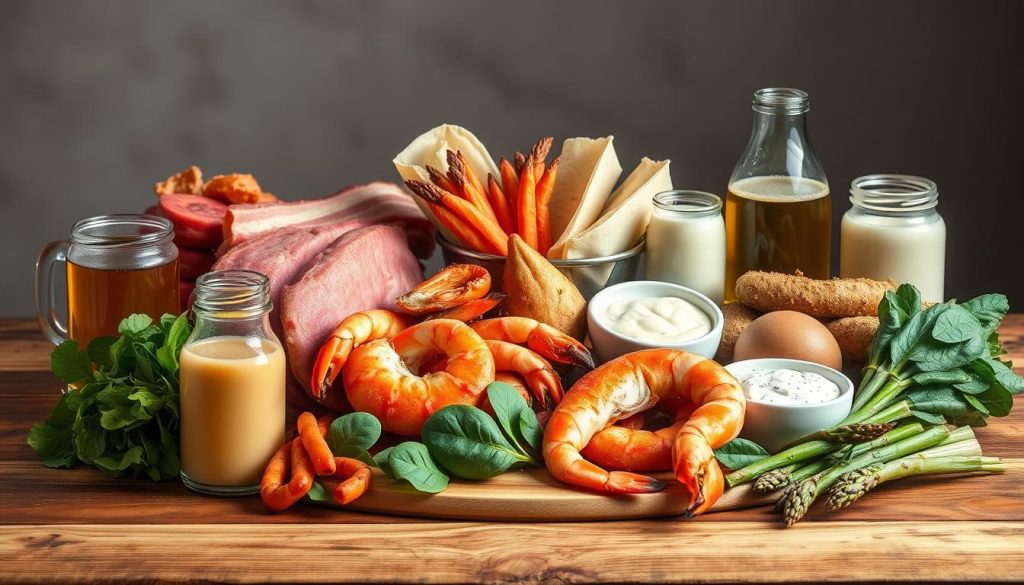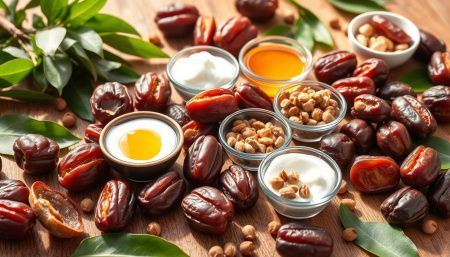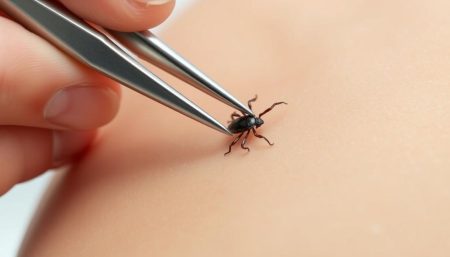Understanding dietary triggers is key for those with gout. Gout is a form of arthritis that causes intense pain and discomfort. It can be triggered by the foods we eat.
Managing gout starts with knowing which foods to avoid. Some foods can make symptoms worse. This means we need to stick to a strict diet to keep gout at bay.
This section will guide you on what to eat and what to avoid. By making the right choices, you can reduce flare-ups and keep your joints healthy.
Knowing what you eat is more than just good health. It’s about taking control of gout. Let’s look at how certain foods affect gout and how to avoid them.
By making smart food choices, you can fight gout’s symptoms. Let’s explore the pantry together and find out which foods to cut out for a better life.
Understanding Gout: Causes and Risk Factors
Learning about gout’s causes is key to managing and preventing it. Gout is a type of inflammatory arthritis caused by too much uric acid in the blood. This excess uric acid forms sharp crystals in joints and soft tissues, leading to pain and swelling.
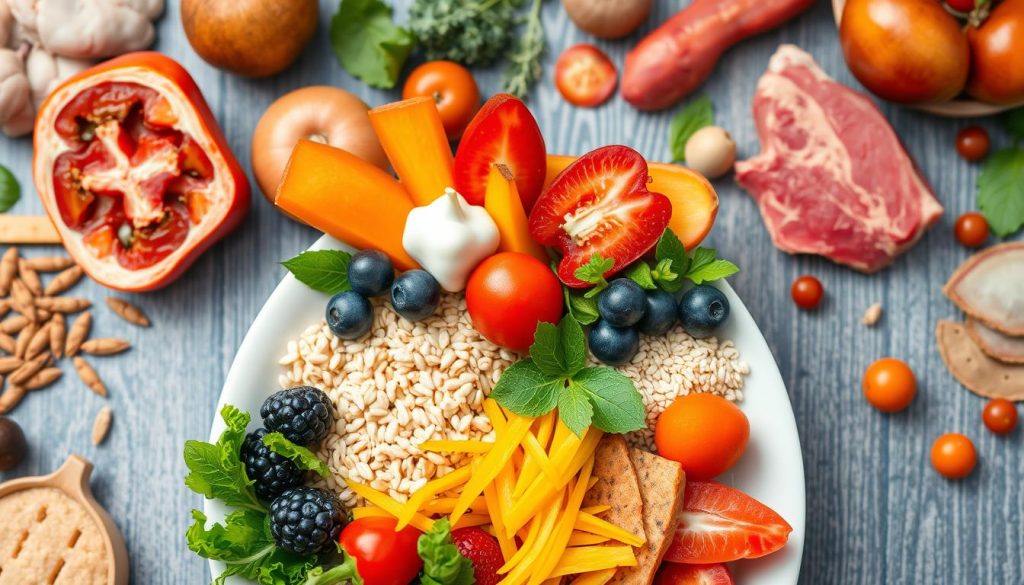
Many things can increase your chance of getting gout. Genetics can play a part, but lifestyle and health also matter a lot. Important risk factors include:
- Being overweight or obese can put extra pressure on your kidneys, making it harder for them to remove uric acid.
- Diseases like hypertension, diabetes, and poor kidney function can also raise your risk of gout.
- What you eat matters too. Eating foods high in purines, like red meats and some seafood, can trigger gout.
Seeing how diet affects gout is very important. Changing your diet to a gout prevention diet can help manage weight and reduce flare-ups. Knowing these factors helps you make lifestyle changes to lessen gout’s impact on your life.
Foods High in Purines: A Gout Trigger to Watch Out For
Understanding which foods trigger gout is key. Foods high in purines can raise uric acid levels, causing pain. Knowing which foods to avoid can help manage gout.
The Chemistry Behind Purines and Uric Acid
Purines are found in the body and some foods. They break down into uric acid during digestion. Normally, uric acid is removed by the kidneys. But, too much can lead to gout.
Identifying High-Purine Foods
To manage gout, it’s important to know which foods to avoid. Here’s a table of common foods and their purine levels:
| Food Category | Examples | Purine Content (mg/100g) |
|---|---|---|
| Very High Purine Foods | Organ meats, game meats, anchovies, sardines, mackerel, scallops | 150-1000 |
| High Purine Foods | Beef, pork, lamb, seafood like tuna, herring, mussels | 100-149 |
| Moderate Purine Foods | Poultry, shellfish, oatmeal, wheat bran, wheat germ | 50-99 |
| Low Purine Foods | Fruits, eggs, cheese, coffee, chocolate | 0-49 |
Using this table, people at risk for gout can make better food choices. It’s not about cutting out all high purine foods. It’s about eating them in moderation to keep uric acid levels in check.
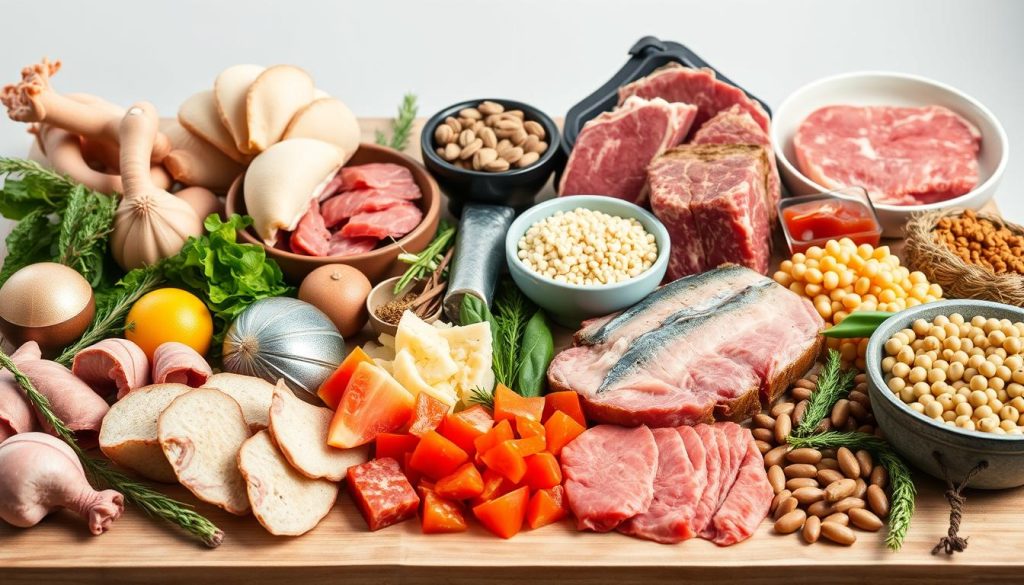
Red Meat and Seafood: Increased Gout Attack Risk
For those with gout, knowing which foods to avoid with gout is key. A gout-friendly diet helps manage the condition. Red meat and some seafood are high in purines, which can lead to gout attacks. This part talks about why these foods are risky and how to eat them in moderation.
Red meats like beef, lamb, and pork, and seafood like anchovies, sardines, and mackerel, have a lot of purines. Eating them often can raise uric acid levels in your blood. This can cause crystals to form in your joints, leading to gout’s painful symptoms.
- Avoid or reduce intake of high-purine red meats.
- Limit seafood that is known to exacerbate gout symptoms.
Making these dietary changes is vital for managing and preventing gout’s painful episodes. Choosing lower-purine foods or plant-based proteins can help control uric acid levels. This supports a healthier lifestyle.
Foods Bad for Gout and Their Alternatives
Managing a gout-friendly diet means finding good substitutes for foods high in purines. This includes avoiding red meat and some seafood. The right alternatives are not only good for gout but also tasty and nutritious. They help keep meals enjoyable and healthy.
Substituting Red Meat
Red meat can trigger gout because it has a lot of purines. Instead, try poultry, tofu, and legumes. They offer protein with much less purine, making them great for a gout diet.
- Poultry (skinless turkey or chicken)
- Tofu and tempeh
- Lentils and beans
Seafood Alternatives for a Gout-Friendly Diet
Some seafood, like mackerel and anchovies, are high in purines. But, there are safer seafood options for a gout diet. Here are some lower-purine seafood choices:
| Seafood Type | Purine Content (Approx.) |
|---|---|
| Salmon | Moderate |
| Scallops | Low to Moderate |
| Shrimp | Low to Moderate |
The Role of Sugar in Gout Flare-Ups
Sugar, mainly fructose, plays a big role in managing gout flare-ups. Eating too much sugar can raise uric acid levels in the blood. This increases the chance of painful gout attacks. To lower these risks, sticking to gout diet restrictions is key.
Sweetened Beverages: A Sugary Danger
Sweetened drinks are a big source of sugar. Soft drinks, fruit juices, and energy drinks have lots of fructose. This raises the risk of gout attacks. To avoid gout foods, cut down or stop drinking these.
Reading Food Labels for Hidden Sugars
It’s important to learn how to read food labels to spot hidden sugars. Many processed foods have added sugars with names that aren’t obvious. Look out for terms like corn syrup, dextrose, fructose, and high fructose corn syrup.
Knowing how to read labels helps make better choices. It helps avoid harmful sugars and follow gout diet restrictions.
Alcohol Intake: Understanding Its Impact on Gout
Looking into how alcohol affects gout is key when talking about gout trigger foods and gout diet restrictions. Alcohol, mainly beer and spirits, messes with how the body handles uric acid. This can cause more gout attacks.
Research shows that different alcohols raise gout risk in different ways. Drinking in moderation or avoiding alcohol altogether is important for managing or stopping gout.
| Type of Alcohol | Level of Risk |
|---|---|
| Beer | High |
| Spirits | Medium to High |
| Wine | Low to Medium |
Even though some say a little wine is okay, beer and spirits are big troublemakers for uric acid levels. Beer, both with and without alcohol, has lots of purines. This greatly increases the chance of a gout attack.
If you want to control your gout symptoms or lower your risk, check your drinking habits. Following gout diet restrictions can help lessen risks. It can also lead to a healthier life, without gout’s pain.
Dairy Products: Good or Bad for Gout?
Understanding dairy’s role in a gout-friendly diet is key. Studies have shown how dairy affects uric acid levels. This is important for managing or preventing gout symptoms.
Low-fat dairy is often suggested for a gout-friendly diet. It may help lower uric acid levels. On the other hand, high-fat dairy products are often avoided. They have more purines, which can raise uric acid levels.
Here’s a breakdown of dairy product categories and their general suitability for those managing gout:
- Low-fat milk – Often regarded as beneficial, low-fat milk can help reduce uric acid concentration.
- Yogurt – Low-fat yogurt is another good choice that may aid in gout management without the risks associated with higher fat varieties.
- Cheese – Caution is advised with cheese; low-fat cheeses are preferable as part of a gout-friendly diet to minimize the intake of saturated fats which could influence uric acid levels.
It’s important for those affected by gout to consult healthcare providers. They can help tailor dietary choices to individual health needs. Not all dairy products are suitable for everyone, and choices must be made based on personal health conditions and uric acid response.
Incorporating the right type of dairy into a diet can help manage and possibly reduce gout flare-ups. It’s important to know the difference between low and high-fat dairy products. This helps create a diet that includes beneficial foods while avoiding those that might worsen gout conditions.
Gout Diet Restrictions: Navigating a Healthy Eating Plan
Following gout diet restrictions is key to managing and preventing gout’s painful flares. By learning and using the gout prevention diet principles, people can lower their risk of gout attacks. This can also boost their overall health.
The Importance of a Balanced Diet
Keeping a balanced diet is vital for gout management. It means eating a variety of foods that are good for you while following dietary rules to avoid gout. Focus on foods rich in nutrients like fruits, veggies, whole grains, and lean proteins to keep uric acid levels healthy.
Gout Prevention Diet: Key Principles
The gout prevention diet focuses on low purine intake, staying hydrated, and avoiding alcohol and sugary foods. Following these rules helps manage symptoms and leads to a more active and healthy life.
- Avoid high-purine foods like red meats and some seafoods.
- Eat more dairy products, which can lower uric acid levels.
- Drink lots of water to help flush out extra uric acid.
- Limit or avoid alcohol and sugary drinks, as they can trigger gout.
By using these dietary tips, people can make a lasting and effective eating plan within gout diet restrictions. This not only helps manage gout but also promotes a healthier lifestyle. It can also lower the risk of other chronic diseases.
Fruits and Gout: What You Need to Know
Managing gout means knowing how fruit affects uric acid levels. While fruits are good for a gout-friendly diet, some fruits high in fructose can raise uric acid. We’ll look at which fruits are good and which to limit.
Cherries: A Possible Gout Relief?
Cherries are known for helping with gout. They have anti-inflammatory properties that can lower uric acid and reduce gout attacks. Adding cherries to your diet can help manage gout well.
High-Fructose Fruits to Avoid
Some fruits are high in fructose and should be eaten less to stay on a gout-friendly diet. Here’s a list of fruits with high fructose that might worsen gout symptoms:
- Mangoes
- Pears
- Apples
- Oranges
- Watermelon
Reducing these fruits can help control uric acid and lessen gout attacks.
| Fruit | Average Fructose Content |
|---|---|
| Mango | 9.5g per medium fruit |
| Pear | 11.8g per medium fruit |
| Apple | 10.9g per medium fruit |
| Orange | 6.1g per medium fruit |
| Watermelon | 9.6g per wedge |
Vegetables to Include in a Gout-Friendly Diet
Adding a variety of vegetables is key for managing gout through diet. Vegetables are low in purines, making them great for a gout-friendly diet. This section looks at the best vegetables to include and why it’s important to mix things up in your meals.
It’s also vital to know which foods to avoid with gout to prevent flare-ups. We focus on vegetables that are good for gout and also boost your health.
- Leafy Greens: Kale, spinach, and lettuce are full of good stuff and low in purines.
- Cherry Tomatoes: Cherry tomatoes have very little purines and can be enjoyed in small amounts.
- Bell Peppers: Bell peppers come in many colors and are rich in Vitamin C, which helps with gout.
- Zucchini: Zucchini is versatile and great for keeping your diet low in purines.
- Cucumbers: Cucumbers are full of water and help get rid of excess uric acid.
These vegetables are good for gout, but it’s important to cook them without adding high-purine ingredients. Salads with simple, low-fat dressings are a good way to add them to your meals.
| Vegetable | Benefits | Tips |
|---|---|---|
| Kale | Rich in antioxidants and vitamins A, C, K | Use in smoothies or salads |
| Cherry Tomatoes | Low in calories and beneficial for hydration | Add to salads or eat as a snack |
| Bell Peppers | Contains capsaicin, which helps reduce pain and inflammation | Include in stir-fries or as raw snacks |
| Zucchini | Low in calories, high in potassium and manganese | Great for noodles or baked dishes |
| Cucumbers | Supports hydration; contains beta-carotene and fiber | Perfect for salads or juiced |
Legumes and Gout: Are They Safe?
Managing a diet with gout diet restrictions can be tricky. Legumes are often questioned due to their moderate purine content. Yet, research shows they are safer than high-purine meats for gout sufferers. This section looks into how legumes can fit into a gout-friendly diet, providing key nutrients without causing gout symptoms.
Legumes, like beans, lentils, and peas, are packed with protein and fiber. They’re great for your health and help keep your diet balanced. Eating them can also help you stay at a healthy weight, which is key in managing gout. Compared to foods bad for gout like red meats and some seafood, legumes pose a lower risk of raising uric acid levels.
| Food Type | Purine Content | Recommendation for Gout |
|---|---|---|
| Red Meat | High | Limited |
| Seafood | High | Limited |
| Legumes | Moderate | Safe in moderation |
The table above compares the purine content of legumes to foods that are worse for gout. Choosing legumes over these foods can help lower the risk of gout attacks. This aligns with the gout diet restrictions.
Hydration and Gout: The Benefits of Water
Drinking enough water is key to a gout prevention diet. It supports your health and helps manage gout. Water dilutes uric acid in your blood and helps your kidneys get rid of it.
How Water Can Help Manage Uric Acid Levels
Staying hydrated is important, even more so for those with gout. Drinking water can lower the chance of gout attacks. It helps remove excess uric acid, which is a major cause of gout.
This process stops painful uric acid crystals from forming in your joints. Adding water to your diet is a simple way to help manage gout.
The Amount of Water Needed for Gout Prevention
The amount of water you need depends on several factors. These include the weather, how active you are, and your health. For gout prevention, aim for urine that’s light yellow or clear. This shows you’re drinking enough water.
| Daily Water Intake | Benefits for Gout Management |
|---|---|
| 8-12 glasses | Helps dilute uric acid, reduces crystal formation |
| More if exercising | Compensates for water loss through sweat, maintains uric acid balance |
Herbs and Spices: Enhancing Flavor Without Risk
When you’re on a gout-friendly diet, watch what seasonings you use. Many herbs and spices add flavor without causing gout. You don’t have to give up taste when avoiding foods to avoid with gout. Here are some great options that boost flavor without raising uric acid.
Spices and herbs can replace salt and MSG, which are bad for gout. They make food taste great and are good for you. Here are some spices that are both tasty and healthy:
- Turmeric: It’s anti-inflammatory and adds a nice yellow color to food.
- Ginger: It’s anti-inflammatory and can be used fresh, dried, or powdered.
- Cinnamon: It’s sweet without sugar and helps control blood sugar.
- Garlic: It tastes strong and can lower inflammation and improve heart health.
Blending spices can also add depth to your dishes without risk:
- Make a meat rub with turmeric, garlic powder, and black pepper.
- Use cinnamon, nutmeg, and clove for a sweet spice mix in desserts and oatmeal.
Here’s a table to help you choose safe and tasty seasonings for a gout-friendly diet:
| Herb/Spice | Uses | Benefits |
|---|---|---|
| Mint | Great in teas and fresh salads | Helps digestion and boosts immunity |
| Basil | Ideal for pesto, soups, and tomato dishes | Anti-inflammatory, anti-bacterial |
| Rosemary | Perfect for roasted vegetables and meats | Improves circulation, enhances memory |
| Oregano | Excellent in pastas and grilled meats | Antioxidant-rich, antibacterial properties |
Adding these herbs and spices to your gout-friendly diet makes meals exciting and healthy. It shows you can eat well and manage gout without losing flavor or variety.
Gout Flare-Up Foods to Eliminate from Your Diet
Managing gout is not just about treatments and meds. It also means watching what you eat. Some foods can trigger gout attacks. Knowing which ones to avoid can help control symptoms. Here’s a list of foods bad for gout to cut out of your diet.
- Organ Meats (like liver, kidneys, and sweetbreads)
- Game Meats (such as venison, pheasant)
- Certain Seafoods (including mackerel, anchovies, sardines)
- Alcoholic Beverages (like beer and spirits)
- Sugary Foods and Beverages (like sodas, candies)
To avoid gout foods that can cause attacks, limit or remove them from your diet. Foods high in purines raise uric acid levels, leading to gout pain.
Replace high-purine foods with better choices. Choose low-fat, dairy-free, plant-based proteins, and whole fruits. They’re healthier and won’t increase gout risk.
- Replace red meat with lean cuts or poultry
- Opt for plant-based protein sources like lentils and beans
- Incorporate more low-purine vegetables such as cabbage and kale
Watching your diet is key to managing gout. It helps lower flare-ups and keeps you healthy. Always talk to a doctor before changing your diet, if you have health issues.
Balancing a Gout-Friendly Diet with Lifestyle Changes
Keeping a gout prevention diet is key, but it’s even more important with lifestyle changes. A whole approach includes diet, exercise, and stress control. Losing weight safely is also vital because extra pounds can hurt your joints and raise uric acid levels.
Regular exercise is key for weight control and fighting gout. It keeps uric acid levels down and helps your joints stay healthy. Also, managing stress well is important to avoid making gout symptoms worse. Try mindfulness or relaxing activities to help your uric acid levels and feel better.
Changing your lifestyle to fight gout is not just about diet. It’s about how all these changes work together. For more health tips, including diet advice, check out this prevention guide. By combining diet with lifestyle changes, you’re setting yourself up for better health and fighting gout.
FAQ
Q: What foods should you avoid if you have gout?
A: If you have gout, stay away from high-purine foods. This includes red meats, organ meats, some seafood, and certain alcoholic drinks. Also, limit foods and drinks with a lot of fructose or sugar to help manage symptoms.
Q: Can diet alone manage gout effectively?
A: Diet is key in managing gout, but it might not work for everyone. It’s best to use diet and medical treatments together. A healthcare provider can help you find the right mix.
Q: Are high-purine vegetables bad for gout?
A: Most vegetables are safe for gout patients. They’re important for a balanced diet and don’t raise uric acid levels much. They provide essential nutrients.
Q: Can drinking water help with gout management?
A: Yes, drinking water helps manage uric acid levels. It helps flush uric acid from the body. People with gout should drink plenty of water every day.
Q: Is dairy consumption safe for individuals with gout?
A: Low-fat dairy products might be good for gout patients. They can help lower uric acid levels. Choose low-fat or non-fat dairy options.
Q: Are there any fruits to avoid if you have gout?
A: Most fruits are safe, but high-fructose fruits should be eaten in moderation. Fructose can increase uric acid levels. Cherries, though, might be beneficial for gout patients.
Q: Is seafood completely off-limits for people with gout?
A: Not all seafood is bad for gout. Choose lower-purine options like salmon. Avoid high-purine seafood like anchovies, sardines, and mussels.
Q: Can legumes be included in a gout diet?
A: Yes, legumes are okay for gout diets. They have moderate purines but offer health benefits like protein and fiber.
Q: What kind of alcohol is most likely to cause a gout flare-up?
A: All alcohol can cause gout flare-ups, but beer and spirits are worse than wine. It’s best to drink in moderation or avoid it altogether.
Q: Can herbs and spices be used freely in a gout-friendly diet?
A: Yes, herbs and spices are great for adding flavor without causing gout flare-ups. They can replace high-purine condiments in your dishes.
Q: Is it necessary to eliminate all gout flare-up foods from your diet?
A: You don’t have to cut out all high-risk foods, but know which ones trigger your gout. Everyone reacts differently to certain foods.
Q: How do lifestyle changes complement a gout-friendly diet?
A: Lifestyle changes like a healthy weight, regular exercise, and stress management work well with a gout diet. They help prevent flare-ups and improve overall health.












